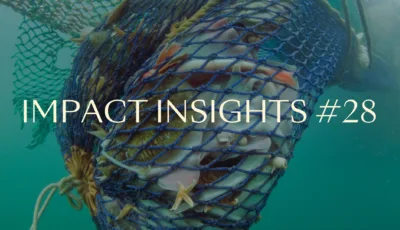Impact Insights #1

With so much happening in the world of impact and sustainability, it can be challenging to stay on top of the latest trends and developments. That's why our impact team has put together Impact Insights. A monthly series to help you stay informed and ahead of the curve. So sit back, relax, and get ready to expand your knowledge on the latest impact and sustainability news from January.
Curated by Norselab's former Sustainability Specialist, Kenza Akallal.
■ COP15: A historic deal to protect nature.
In December, a Global Biodiversity Framework was agreed on during COP15 (“Conference of the Parties''; the formal meeting of the parties in the Convention on Biological Diversity (CBD)) in Montreal. Many see this as biodiversity’s “Paris Agreement” moment.
The framework consists of four overarching global goals: halting biodiversity loss by 2050, ensuring the conservation and sustainable use of nature going forward, sharing benefits from using nature’s resources, and allocating adequate resources for implementation and knowledge sharing. There are also 23 targets to back the goals.
The most notable target is the 30x30 pledge: protecting 30% of land and water by 2030. It’s well documented that climate and biodiversity are connected: our planet's ecosystems, with its biodiversity, are natural climate sinks helping absorb GHG emissions. Breaking down biodiversity, therefore, leaves even more GHG emissions in our atmosphere.
Conversely, the conservation and restoration of nature helps reduce GHG emissions in our atmosphere. So we’re pleased to see the additional momentum COP15 brings to investors on the topic of biodiversity: it’s likely the start of a new market for investors to contribute positively to climate change.
■ The era of nature and biodiversity starts now.
Following COP15, there is already considerable momentum for investors to start addressing biodiversity in their investments, as some already do GHG emissions. 150 financial institutions, managing more than $24 trillion, have signed the Finance for Biodiversity Pledge, which commits them to protecting and restoring biodiversity through their financial activities and investments.
A key challenge going forward is translating the Global Biodiversity Framework into meaningful actions, standards, and frameworks for investors. We’re seeing some promising developments linked to COP15, like the forthcoming environmental objectives in the EU Taxonomy, the draft Guidelines from the World Business Council for Sustainable Development, the draft Task Force on Nature-related Financial Disclosures, the Science-Based Targets for Nature, and WWF’s Risk Filter Suite, all in the works.
■ The global risk of the next decade: climate action failure.
The World Economic Forum’s Global Risks Report 2023 reports that climate action failure is viewed as one of the biggest global risks over the next decade. In fact, six environmental risks feature in the top 10 risks over the next 10 years.
The top risk stems from our lack of progress on climate action targets. The divergence between what is scientifically necessary and what is politically feasible is growing. Biodiversity and ecosystem collapse is the fastest escalating risk, according to the report, due to the lack of attention from society at large. While there is growing investor momentum on climate action and biodiversity, the risk of failure looms.
■ Greenwashing is still in the spotlight.
Despite efforts to better define «sustainable investments» through the new Sustainable Finance Disclosure Regulation (SFDR), the downgrading of funds from Article 9 to Article 8 is a sign that the definitions are anything but clear.
A recent investigation into Article 9 funds (the so-called “dark green” funds), found that many of them invested in fossil fuels and aviation. Sustainable-linked bonds have also been found to function mostly as a financing mechanism to benefit companies and not the planet. In fact, there is so much greenwashing that Planet Tracker, in a new report, has defined at least six different types of greenwashing prevalent among businesses today.
Many are calling for standardized sustainability reporting, such as the EU's Corporate Sustainability Reporting Directive. But its complexity is a symptom of the problem: sustainability is not black or white, and it’s challenging - if not impossible - to expose the full range of impacts of a company through a single lens.
■ BONUS: Busy regulators.
In December, the EU made progress on several fronts for a more sustainable EU:
- The European Trading System (ETS) was updated. ETS is a system that caps the amount of CO2 a company in defined sectors is allowed to emit. Any additional emissions require the purchase of carbon credits on the ETS trading market. From 2024, the maritime sector will be included in the capping system, followed by the road transport and building sectors from 2027. To complement the ETS, a Carbon Border Adjust Mechanism will introduce tariffs on goods from outside the EU to prevent carbon-intensive producers from moving their operations outside of the EU to avoid ETS measures. It will not be fully implemented until 2027. In other words, this might be another initiative that fails to set the right ambitions and pace needed to reach the Paris Agreement goal to limit global warming to 1,5 degrees by 2050.
- A new regulation bans sales of deforestation-linked products in the EU. This will impact palm oil, cattle, soy, coffee, cocoa, timber, and rubber, as well as derived products such as beef, furniture, and chocolate. Companies will have to issue a due diligence statement verifying that the production of these goods has not caused damage to or degradation of forest ecosystems anywhere in the world after 31 December 2020. It’s a step in the right direction following COP15.
- A new regulation aims to favor more sustainable batteries. The regulation requires better QR code labeling on sustainability and performance for consumers, and more stringent targets for waste collection, recycling efficiency, and material recovery. Producers will need to conduct due diligence to address social and environmental risks. And, by 2030, the Commission will assess whether to phase out the use of non-rechargeable portable batteries.
Sign up to our newsletter to get the next Norselab Impact Insights straight into your inbox.


